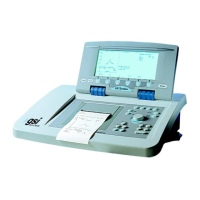Description
DPRAM - Dual Port RAM memory test failure
Subcodes: None.
Likely Causes: Most likely hardware failure with DPRAM on
Digital board or any address/data lines that run to the
DPRAM.
Invalid keycode detected – keycode out of range.
Subcodes: keycode detected.
Likely Causes: This is one of the internal checks for the
keyboard handler
.
This indicates an internal software failure.
Invalid keycode handler function detected by menu handler.
Subcodes: keycode that is currently being processed.
Likely Causes: This is one of the internal checks for the
keyboard handler
.
This indicates an internal software failure.
The key queue has filled and additional keys are detected that
cannot be stored by the software.
Subcodes: keycode of the last key that attempted entry into
the queue.
Likely Causes: The key queue is very large and keys cannot
be pressed fast enough to fill it. This is most likely a
hardware problem with keys. It could also mean that the CP
software (PC104) has stopped processing keys, but continues
to queue them up until the buffer fills (this is less likely).
SP does not respond to communication request by CP
Subcodes: none
Likely Cause: When the system is first booted, the DPRAM
is enabled and the SP is taken out of reset (i.e
.
initialized) and
must respond to the CP’s communication request within 30
seconds. If the SP does not respond, there could be an
internal SP problem or the hardware path between the SP and
CP could be faulty.
Timeout on wait for SP to complete the last set of commands.
Subcodes: command opcode
Likely Cause: There are numerous commands that travel
between the CP and SP; if the SP is not responding for any
reason this error code will likely occur. It is most likely a
problem with the SP itself (for example, if the SP gets reset
by high-current power spike) or with a faulty hardware path
between the SP and CP.
Grason-Stadler

